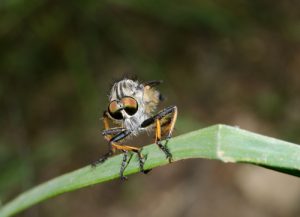Not for the Squeamish! Squirrel Bot Flies
By Chris Williams on January 3, 2012.
Q. We have a lot of squirrels around our house. A couple of weeks ago, I saw a squirrel with a lump on its neck. I assumed it was from a bite or something, but then I saw another squirrel with a lump about the size of a pecan on its back. Are these some kind of cancerous tumors that squirrels get?
A. No, I think what you’ve seen is squirrels that have been parasitized by bot flies. The lump is called a “warble” and it contains the larva of the bot fly. The adult bot fly looks something like a bumble bee, black and yellow with a large body. You can tell it from a bumble bee by looking at the wing pairs—bees have two pairs of wings; flies only one. The squirrel bot fly is a natural parasite of the eastern gray squirrel, fox squirrel, American red squirrel, and eastern chipmunk. These “lumpy squirrels” are a fairly common sight from mid to late summer in the eastern U.S.
The mated female bot fly lays her eggs on twigs and branches. Squirrels get infested when they touch the eggs. The warmth from the squirrel’s body causes the eggs to hatch almost immediately and the larvae then crawl onto the squirrel’s body. The larvae enter the squirrel’s body through a natural opening, or are swallowed when the squirrel licks itself, or sometimes burrow in through its eye.
 The bot fly larva lives in the squirrel’s body, eventually settling under the skin, where it is visible as a conspicuous, hairless lump, one larva per warble. The larva grows inside this warble for about three weeks, reaching its maximum size of about 1-1/2 inch long by 1 inch wide. This is a large parasite for a little squirrel! When the larva is mature, it drops out of the skin through a pre-cut hole, leaving a rather ugly-looking, ulcerated wound. The larva then pupates in the soil. All of this sounds (and looks) rather gruesome and you would think that carrying this big fly larva around would affect the squirrel. It doesn’t seem to.
The bot fly larva lives in the squirrel’s body, eventually settling under the skin, where it is visible as a conspicuous, hairless lump, one larva per warble. The larva grows inside this warble for about three weeks, reaching its maximum size of about 1-1/2 inch long by 1 inch wide. This is a large parasite for a little squirrel! When the larva is mature, it drops out of the skin through a pre-cut hole, leaving a rather ugly-looking, ulcerated wound. The larva then pupates in the soil. All of this sounds (and looks) rather gruesome and you would think that carrying this big fly larva around would affect the squirrel. It doesn’t seem to.
If the empty warble doesn’t become infected, it heals shut in about a week, the fur grows back, and the squirrel is none the worse for the experience. Bizarre as it seems, bot flies are a natural part of a squirrel’s ecology. A veterinarian or a wildlife rehabilitator could remove the bot larva with tweezers, but there is really no reason to do so and the process could be more stressful to the squirrel than simply letting the fly’s lifecycle runs its course.
I know your next question is going to be, “Can people or pets be infested by bot flies?” Not by squirrel bot flies. Other animals, including humans, each have their own bot flies of different species. Fortunately, the human bot fly does not occur in the U.S. but is sometimes seen (rarely) in people who have traveled to Latin America. Some entomologists and biologists who end up with a bot fly under their skin from their travels will purposely let the larva complete development, then collect and rear out the fly so they can identify the species and have the specimen for their collection. Now that’s scientific curiosity!